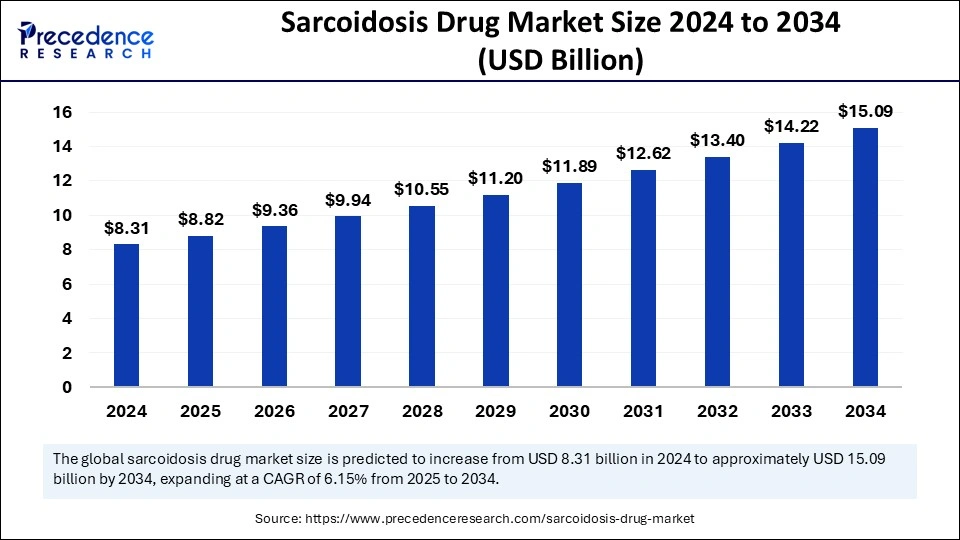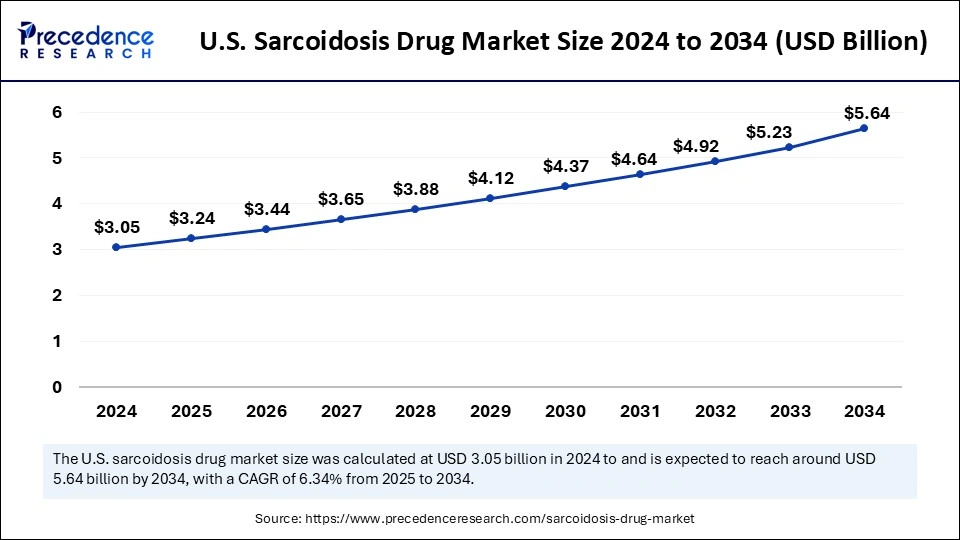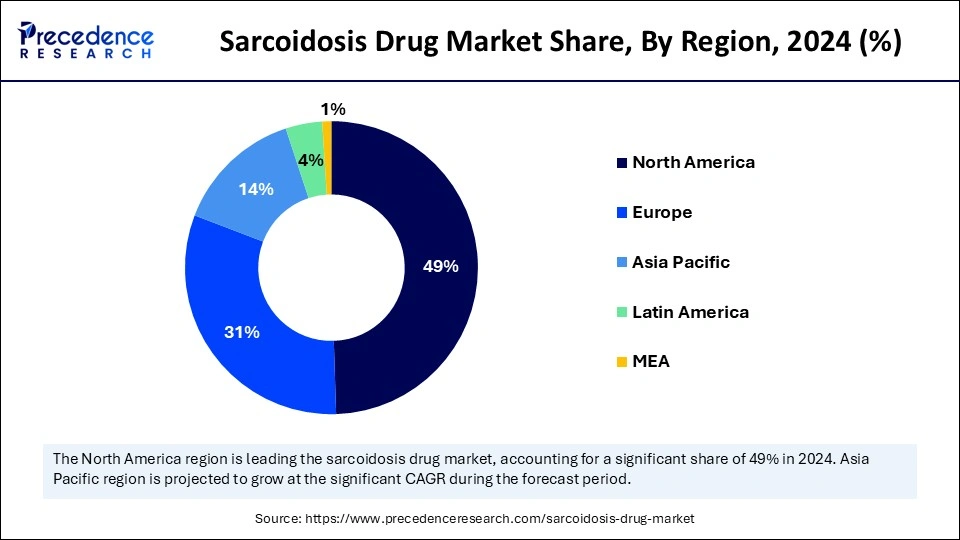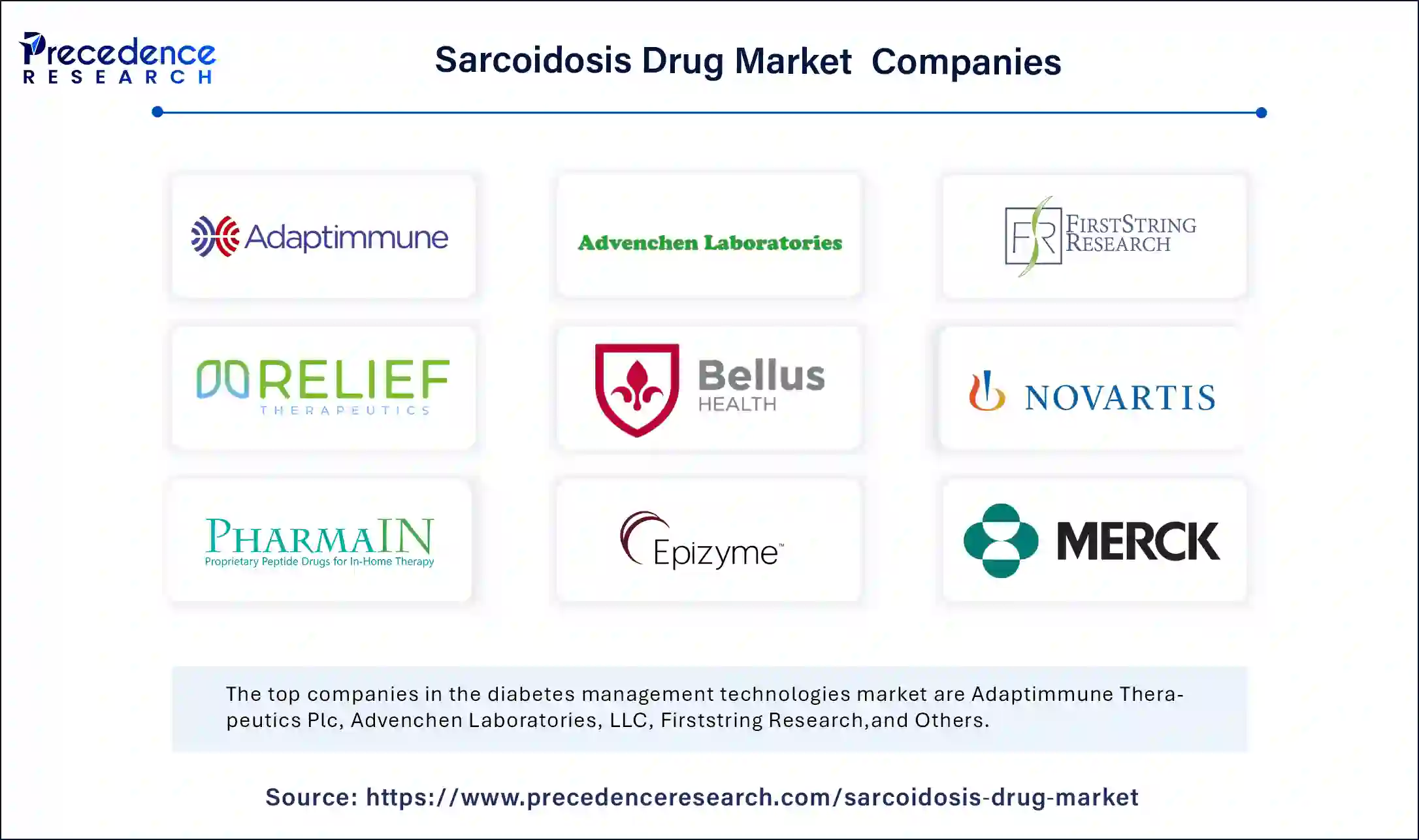August 2024
The global sarcoidosis drug market size is calculated at USD 8.82 billion in 2025 and is forecasted to reach around USD 15.09 billion by 2034, accelerating at a CAGR of 6.15% from 2025 to 2034. The North America market size surpassed USD 4.07 billion in 2024 and is expanding at a CAGR of 6.26% during the forecast period. The market sizing and forecasts are revenue-based (USD Million/Billion), with 2024 as the base year.
The global sarcoidosis drug market size accounted for USD 8.31 billion in 2024 and is predicted to increase from USD 8.82 billion in 2025 to approximately USD 15.09 billion by 2034, expanding at a CAGR of 6.15% from 2025 to 2034. The market is growing because of the rising prevalence of sarcoidosis, necessitating prompt diagnosis and efficient therapies. Focused therapies, non-invasive diagnostic methods, and innovative drugs are driving market expansion, enhancing patient outcomes, and reducing the use of corticosteroids.

Artificial intelligence (AI) is transforming the sarcoidosis drug market by enhancing research, clinical studies, and patient treatment. AI is capable of recognizing biomarkers, reassigning medications, and enhancing clinical trials. It also helps in diagnosing sarcoidosis, differentiating it from other lung conditions, developing predictive models for patient outcomes, and classifying patients into specific phenotypes for specialized treatment. The incorporation of AI technologies, such as machine learning and deep learning, is tackling the challenges of this rare disease.
The AI-driven Dr. Sarcoidosis serves as a virtual assistant aimed at improving patient education and management of sarcoidosis by offering tailored information, responding to questions, and assisting in disease management, ultimately boosting patient involvement and adherence to treatment.
The U.S. sarcoidosis drug market size was exhibited at USD 3.05 billion in 2024 and is projected to be worth around USD 5.64 billion by 2034, growing at a CAGR of 6.34% from 2025 to 2034.

North America Drives Sarcoidosis Innovations
North America dominated the sarcoidosis drug market in 2024 because of the increased prevalence of the disease, especially with cardiac involvement, robust healthcare infrastructure, active research and development programs, and partnerships among pharmaceutical companies, academic entities, healthcare professionals, and patient advocacy organizations. The well-established healthcare infrastructure in the region enables early detection and thorough management of sarcoidosis, offering patients specialized treatment and access to the most current therapeutic choices. The involvement of major pharmaceutical companies and research organizations fosters advancements in sarcoidosis therapy, while partnerships between these areas improve knowledge sharing and speed up disease management approaches.
The U.S. Market Trends
The U.S. leads the sarcoidosis drug market because of its significant prevalence and awareness, substantial research funding, powerful pharmaceutical sector, and developed healthcare system. The elevated prevalence rates of the nation, especially within African-American communities, along with specialized facilities, lead to a greater need for effective therapies. The U.S. possesses a strong healthcare infrastructure, leading research organizations, and an efficient approval procedure. Moreover, government programs and strategic partnerships among universities, private companies, and public agencies further improve drug development and patient care methods.

Asia Pacific: An Emerging Force in Sarcoidosis Treatments
Asia Pacific is observed to host the fastest-growing sarcoidosis drug market during the forecast period due to increasing prevalence rates, governmental efforts, a burgeoning pharmaceutical sector, and improved access to healthcare. Nations such as China and India are experiencing elevated diagnosis rates, resulting in greater healthcare use. Governments and global organizations are offering grants and financial support for research and development in sarcoidosis therapies. The emerging pharmaceutical sector is driving advancements in drug development specifically targeting sarcoidosis. Enhancements in healthcare infrastructure in nations such as India, China, and Japan have increased patient access to specialized treatment. Collaborative educational programs, such as the Asia Pacific Rheumatology Intensive Scientific Education (ARISE), aim to address the growing challenges posed by rheumatologic diseases in the region.
India Advancing Sarcoidosis Drug Development
The sarcoidosis drug market in India is witnessing swift expansion owing to heightened public awareness and improved healthcare access. Government programs and enhanced funding for research have resulted in the creation of new treatment alternatives. The Sarcoidosis Research Foundation (SRF) in India offers substantial financial support to scientists, encouraging innovative studies. The growing pharmaceutical industry is dedicated to developing biosimilars and biologics for the treatment of sarcoidosis. Specialized institutions such as Amrita Hospital's Sarcoidosis and ILD Clinics in Kochi emphasize focused healthcare. Government-backed initiatives, such as the Ayushman Bharat scheme, enhance the affordability and accessibility of healthcare for chronic conditions like sarcoidosis.
China: A Key Force
The sarcoidosis drug market of China is led by its rising incidence and developing healthcare system. The government has emphasized enhancing healthcare and has boosted funding for research on chronic conditions, such as sarcoidosis. Partnerships between domestic pharmaceutical companies and global research organizations are improving drug development for sarcoidosis. The development of China is driven by improvements in healthcare systems, funding in research and innovation, and partnerships with international pharmaceutical companies. In 2023, the Chinese Rare Diseases Consortium launched a national initiative aimed at enhancing the early diagnosis and therapy of rare diseases, promoting market expansion.
Europe: A Notable Position in the Global Market
Europe is considered to be a significantly growing area in the sarcoidosis drug market because of its strong healthcare infrastructure, considerable research funding, and high incidence of the condition. The regulatory structure of the region streamlines the authorization of new therapies, guaranteeing patients access to advanced treatments. European nations are progressively acknowledging the necessity for specialized treatments, resulting in cooperation among pharmaceutical firms and research organizations. The Horizon Europe initiative, along with the involvement of top pharmaceutical companies and patient advocacy organizations, enhances the market of Europe standing in rare diseases.
The sarcoidosis drug market is a pharmaceutical sector dedicated to manufacturing and marketing treatments for sarcoidosis, an inflammatory condition characterized by clusters of inflammatory cells known as granulomas that develop in different organs such as lungs, lymph nodes, skin, and eyes. These granulomas can lead to inflammation of organs. This illness is activated by the reaction of the immune system to external substances like bacteria, viruses, or chemicals. Main therapies consist of corticosteroids, immunosuppressants, biologics, and anti-malarial medications. These medications are intended to decrease inflammation and control symptoms.
| Report Coverage | Details |
| Market Size by 2034 | USD 15.09 Billion |
| Market Size in 2025 | USD 8.82 Billion |
| Market Size in 2024 | USD 8.31 Billion |
| Market Growth Rate from 2025 to 2034 | CAGR of 6.15% |
| Dominated Region | North America |
| Fastest Growing Market | Asia Pacific |
| Base Year | 2024 |
| Forecast Period | 2025 to 2034 |
| Segments Covered | Type, Mechanism of Action, , Drug Type, End User, and Regions |
| Regions Covered | North America, Europe, Asia-Pacific, Latin America and Middle East & Africa |
Increased focus on research and development
The sarcoidosis drug market is propelled by research and development aimed at novel treatments and enhancing patient results. This has resulted in the development of targeted treatments and personalized medicine strategies that tackle the intricate nature of the illness. Present therapies frequently depend on the off-label application of corticosteroids and immunosuppressants, potentially resulting in adverse effects and a lack of efficacy. Consequently, investigating new treatments is essential.
Higher cost of developing and accessing novel therapies
Sarcoidosis is a rare condition that complicates the processes of clinical trials and raises costs. This complicates the recruitment of enough patients for extensive trials, causing holdups in the creation and authorization of new treatments. The high cost of developing and accessing novel therapies, requiring considerable investment in research, clinical testing, and regulatory approvals, may restrict patient access, particularly in areas with limited healthcare coverage.
Increased focus on novel and targeted treatments
The increased focus on novel and targeted treatments for sarcoidosis has greatly enhanced safety standards and effectiveness. Conventional therapies, such as corticosteroids, frequently cause notable side effects, highlighting the importance of creating treatments that accurately adjust the immune response, targeting the root causes of the condition.
The pulmonary sarcoidosis segment held a significant share in the sarcoidosis drug market in 2024 because it is characterized by the presence of granulomas in the lungs and is the most common type of sarcoidosis, impacting 90% of individuals. The significant prevalence fuels the need for specific treatments and investigations centered on pulmonary symptoms. Market dominance is linked to elevated prevalence rates, continuous research into innovative therapies, and heightened awareness among healthcare providers and patients. Serious issues such as pulmonary hypertension and permanent lung fibrosis underscore the necessity for targeted treatments.
The cutaneous sarcoidosis segment is seen to grow at the fastest rate in the upcoming years, as awareness of skin symptoms as major signs of sarcoidosis rises. This segment impacts 25% to 30% of patients, ranking as the second most prevalent manifestation following pulmonary involvement. The main factors consist of heightened awareness, progress in treatment alternatives, and continuous research and clinical studies. Cutaneous sarcoidosis impacts about one-third of individuals with sarcoidosis, influencing their quality of life and leading to psychological discomfort. The restricted number of FDA-approved therapies and the study of molecular pathways are aiding in the development of targeted treatments.
The corticosteroids segment held a dominant presence in the sarcoidosis drug market in 2024 because it serves as the main treatment choice for sarcoidosis because of their ability to lower inflammation and inhibit the activity of the immune system. They are readily accessible and affordable, establishing them as the main treatment choice. Corticosteroids block essential cytokines such as TNF-α and IFN-γ, vital for granuloma development. This renders them essential for managing symptoms and averting organ damage in patients with sarcoidosis. Experts widely agree that corticosteroids ought to be the first-line treatment for patients in need of therapy. They are broadly recognized for their quick action and efficacy in different types of sarcoidosis, and their flexible administration methods (oral, inhaled, topical) additionally improve their application.
The Tumor Necrosis Factor-alpha (TNF-α) Inhibitors segment is expected to witness the fastest rate of growth during the predicted timeframe because of their specific mechanism of action that targets the fundamental inflammatory processes. TNF-α, an important cytokine in the development of sarcoidosis, plays a role in the creation and preservation of granulomas. Inhibitors such as infliximab and adalimumab have demonstrated considerable effectiveness in managing refractory sarcoidosis patients who do not respond well to corticosteroids. Clinical evidence supports their efficacy in treating sarcoidosis symptoms unresponsive to conventional steroid treatment. As additional clinicians recognize their possible advantages, their usage is expected to rise.
The prednisone segment dominated the sarcoidosis drug market with the highest share in 2024 because it is a commonly acknowledged primary therapy for treating sarcoidosis. As a corticosteroid, it diminishes the immune reaction, lessens inflammation, and relieves symptoms, especially in respiratory cases. Clinical guidelines consistently support prednisone as the standard therapy, highlighting its significance as a fundamental treatment. Its extensive acceptance, affordability, and clinical familiarity render it a favored option among healthcare professionals for extended treatment. The effectiveness of prednisone in managing inflammation and its extensive usage led to its market prevalence.
The methotrexate segment is anticipated to grow at the fastest rate in the market during the forecast period because it is a non-steroidal treatment becoming increasingly favored in the sarcoidosis drug market because of its efficacy in addressing sarcoidosis affecting the lungs, skin, and additional organs. Its adaptability and immune-suppressing characteristics render it advantageous for patients needing extended therapy for chronic or resistant sarcoidosis. The positive safety profile of Methotrexate makes it an appealing alternative to corticosteroids for extended use, rendering it a preferred option for patients who cannot endure prolonged corticosteroid treatment.
The hospitals & clinics segment dominated with the largest share in the market in 2024 because of their extensive multidisciplinary care, availability of advanced diagnostic and treatment resources, and dedicated sarcoidosis initiatives. These centers offer patients the newest therapies, clinical studies, and specialized care plans, guaranteeing comprehensive and effective management for this complex condition. Their tailored initiatives center on research, educating patients and advanced therapeutic approaches, improving patient results, and bolstering their market presence.
The surgical centers are projected to expand rapidly in the sarcoidosis drug market in the coming years due to progress in minimally invasive diagnostic and therapeutic methods. Sarcoidosis may result in complications such as ongoing pneumothorax or significant organ dysfunction, requiring surgical procedures like lung resections or lymph node removals at specialized surgical centers. Sophisticated methods such as Endobronchial Ultrasound-Guided Transbronchial Needle Aspiration and Video-Assisted Thoracoscopic Surgery enhance diagnostic accuracy, while targeted surgical procedures are conducted for complications. The incorporation of surgical centers into multidisciplinary teams guarantees thorough patient care.

By Type
By Mechanism of Action
By Drug Type
By End User
By Geography
For inquiries regarding discounts, bulk purchases, or customization requests, please contact us at sales@precedenceresearch.com
No cookie-cutter, only authentic analysis – take the 1st step to become a Precedence Research client
August 2024
June 2023
January 2025
November 2024